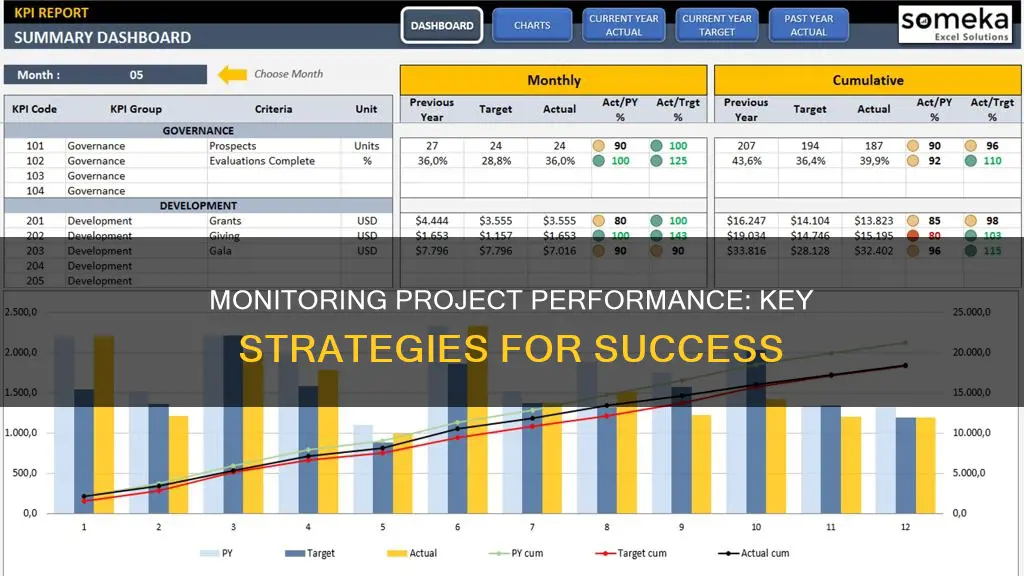
Monitoring project performance is a critical aspect of project management, ensuring that projects stay on track and meet their objectives. It involves tracking various metrics such as scope, timeline, budget, and resources to identify potential risks and make necessary adjustments. Effective monitoring helps identify issues early on, optimise resource allocation, and enhance accountability among team members. It also enables project managers to compare actual progress against planned milestones and take corrective actions to keep projects within the estimated scope. This process is essential for maximising profit, delivering quality results, and ensuring overall project success.
| Characteristics | Values |
|---|---|
| Project goals | Measurable, achievable, relevant, time-bound |
| Project deliverables | Clear delivery dates, acceptable levels of delay |
| Project schedule | Man hours per task, resources needed |
| Project risks | Budget cuts, inefficient flow of information, raised costs, incorrect estimation of resources, changing requirements |
| Project monitoring tools | monday.com, MS Project, project management software |
| Project monitoring frequency | Weekly, monthly, quarterly, by sprint, by project phase |
| Data collection | Automation tools, questionnaires, surveys, focus groups |
| Reporting | Status reports, progress updates, meetings |
| Project scope | Prevent scope creep, set expectations with stakeholders |
| Project timeline | Milestones, deadlines |
| Project budget | Cost, budget alignment |
| Project resources | Communication tools, time tracking tools |
| Project control | Re-allocating resources, revising schedules, updating project plans, redistributing tasks, updating budget expectations |
What You'll Learn

Set goals and expectations
Setting goals and expectations is a crucial step in monitoring project performance. It provides a clear direction for the team and helps to ensure that everyone is working towards the same objectives. Here are some key points to consider when setting goals and expectations:
Identify Stakeholders and Their Needs:
Begin by identifying all the stakeholders involved in the project. This includes anyone who is directly or indirectly affected by the project, such as end users, customers, the project manager, team members, and sponsors. Once you have a list of stakeholders, work on understanding their needs. This can be done through interviews, surveys, or focus groups. It is important to prioritise these needs, as not all of them may be able to be met.
Define Measurable Goals:
Turn the prioritised list of goals into measurable, achievable targets. One effective framework for this is the SMART principle, which states that goals should be specific, measurable, achievable, relevant, and time-bound. For example, if one of the goals is to increase customer satisfaction, a specific and measurable target could be to achieve a customer satisfaction rating of 80% or higher within the next six months.
Establish Key Performance Indicators (KPIs):
KPIs are measurable values that help to determine how well the team is meeting the project goals. Examples of KPIs include net profit, overall cost, efficiency, budget, timeline, and quality standards. It is important to decide on these KPIs early on so that you can track and evaluate the project's performance against them.
Set Regular Check-Ins and Meetings:
Regular check-ins or meetings with the project team are essential to providing feedback, addressing issues, and ensuring everyone understands the long-term goals. This also provides an opportunity to evaluate progress and make any necessary adjustments to stay on track. These meetings should be scheduled at a frequency that works for your team and project timeline, whether that is weekly, bi-weekly, or monthly.
Assign Responsibilities and Reporting Lines:
Clearly define who is responsible for monitoring the project, conducting evaluations, and reporting significant findings to management and stakeholders. This helps to ensure accountability and provides a point of contact for any questions or concerns. Additionally, establish a common format and frequency for reporting, such as weekly progress reports or monthly status updates.
By following these steps, you can effectively set goals and expectations for your project, providing a solid foundation for successful monitoring and execution.
The Brilliance of Self-Lit LCD Displays
You may want to see also

Choose a data collection method
There are several ways to collect data from your team. You can ask project participants to self-report, but this may require extra time spent on reminders and tracking down details. An easy way to help everyone remember and ensure you get the information you need is to have a standing meeting at a chosen interval. This could be a quick weekly meeting where everyone reports their progress.
Alternatively, you could use a self-reporting system, and set up reminders to request weekly reports.
Another option is to use a questionnaire or survey. This method is simple to create and get results from. A large number of people across various cross-sections of stakeholders can be reached relatively easily, and it is less of a hassle for them to respond. People can also choose to withhold their information while still participating, and the data can be analysed critically once received.
You could also use feedback forms, which can be distributed and completed at a time when users have just used a product or been in direct contact with your team.
For a more in-depth data collection method, you could conduct interviews. These require more preparation and time, but the interviewer can probe for relevant information. Although they are most effective in person, they can also be conducted over the phone.
Focus groups are another way to gather first-hand information. By putting together a good cross-section of stakeholders in a room together, you can allow them to answer some pointed questions but also speak freely and ignite new ideas through each other.
Once you have chosen your collection method, use it consistently so it's a reliable resource for keeping everything on track.
Connecting a Monitor to Behringer Eurorack: Easy Steps
You may want to see also

Make project tracking a team effort
Project tracking is a collaborative effort that requires the involvement of the entire team. Here are some strategies to make project tracking a team effort:
Encourage a Culture of Transparency and Collaboration:
Foster a culture where team members feel comfortable sharing their progress, challenges, and updates. Encourage open communication and ensure that everyone understands the importance of tracking and providing accurate information. This will help identify potential issues and ensure that the project stays on track.
Define Clear Roles and Responsibilities:
Clearly define the roles and responsibilities of each team member in relation to project tracking. Ensure that everyone knows what they are accountable for and how their contributions fit into the bigger picture. This will help avoid confusion and ensure that all necessary aspects of the project are being tracked effectively.
Utilize Project Tracking Tools:
Invest in user-friendly project tracking software or tools that can help streamline the tracking process. Look for tools that offer real-time updates, progress reports, and the ability to track tasks at both the individual and project levels. This will make it easier for team members to provide updates and stay aligned with the project's progress.
Establish Regular Check-Ins and Reporting:
Implement a system of regular check-ins or status meetings where team members can report on their progress. This could be done through weekly team meetings, individual check-ins, or a combination of both. Ensure that reporting is consistent and timely, allowing for early identification of any potential issues.
Provide Training and Support:
Offer training and support to team members on how to use the project tracking tools effectively. This could include tutorials, webinars, or one-on-one sessions to ensure that everyone understands the system and can input their data accurately.
Emphasize the Benefits of Project Tracking:
Help team members understand the benefits of effective project tracking. Highlight how it can improve efficiency, reduce bottlenecks, and ultimately contribute to the success of the project. When team members see the value in the process, they are more likely to buy into the idea and actively participate.
Effective Ways to Remove Streaks and Smears from Your Monitor
You may want to see also

Utilise project tracking tools
Project tracking tools are essential to keeping projects on schedule and within budget. They allow project managers to monitor the progress of their team and the execution of tasks in real-time. There are various types of tools and software available to support project tracking, from spreadsheets to project management software.
Spreadsheets are a good way to track key metrics, with versatile functions to keep track of tasks, prioritise responsibilities, assign duties and handle other monitoring tasks. They also allow for colour-coding and easy organisation of information.
However, for larger, more complex projects, a tracking application or project management software is recommended. These tools can help to streamline workflows, such as data and feedback collection, and allow for the generation of reports on performance and key metrics. They also enable users to view team workloads and monitor progress using different views, such as calendar, kanban board, chart or timeline views.
Project tracking software is particularly useful for monitoring budgets and resource management. It can help to identify issues that may prevent the project from staying on schedule and within budget and allow managers to have access to data in real-time. Features such as dynamic Gantt charts, alerts and notifications, and timesheet functions can help to automate the project tracking process and ensure everyone is kept up to date.
Project tracking templates can also be used as a single source of data for the project's progress. These templates can be shared with the project manager and stakeholders to show the project status at a given time.
Asus Frameless Monitors: Speakers or No Speakers?
You may want to see also

Establish clear communication
Clear communication is essential for effective project monitoring. Here are some steps to ensure clear and transparent communication throughout the project monitoring process:
Define Communication Channels and Cadence:
- Establish a communication plan that outlines the methods, cadence, and tools for communication.
- Determine the frequency of communication, such as weekly, bi-weekly, or monthly check-ins, and stick to the schedule.
- Utilize a combination of meetings, emails, and project management software to ensure regular and consistent communication.
Encourage Open Dialogue:
- Foster an environment where team members feel comfortable sharing updates, roadblocks, feedback, and timelines.
- Facilitate regular discussions on deliverables, challenges, and timelines to ensure everyone is on the same page.
- Ensure that communication is a two-way street, with both top-down and bottom-up exchanges of information.
Standardize Reporting:
- Create a standardized format for reporting project progress, including key metrics, milestones, and any issues encountered.
- Utilize project management software or tools to automate reporting and ensure data accuracy.
- Make sure that reports are tailored to the appropriate management level, providing the right level of detail for effective decision-making.
Promote Transparency:
- Share relevant information with all stakeholders, including project plans, timelines, budgets, and risks.
- Provide updates on project progress, including any deviations from the initial plan, to maintain trust and confidence.
- Be transparent about any challenges or issues, and involve stakeholders in finding solutions.
Foster Collaboration:
- Encourage cross-functional collaboration by providing a platform for team members to interact and share ideas.
- Utilize collaboration tools within project management software to facilitate real-time exchanges and problem-solving.
- Ensure that communication tools are user-friendly and accessible to all team members.
By implementing these steps, project managers can establish clear communication channels, promote transparency, and foster a collaborative environment, ultimately contributing to effective project monitoring and increased chances of project success.
Best Places to Buy Monitors: A Comprehensive Guide
You may want to see also
Frequently asked questions
The key steps of project monitoring are initiation, planning, executing, monitoring and controlling, and closing.
Some challenges in project monitoring are data accuracy, scope creep, resource constraints, reporting, and miscommunication.
Project monitoring helps to ensure project success, identify issues early on, optimise resource allocation, encourage accountability, and quickly identify variances and deviations.







